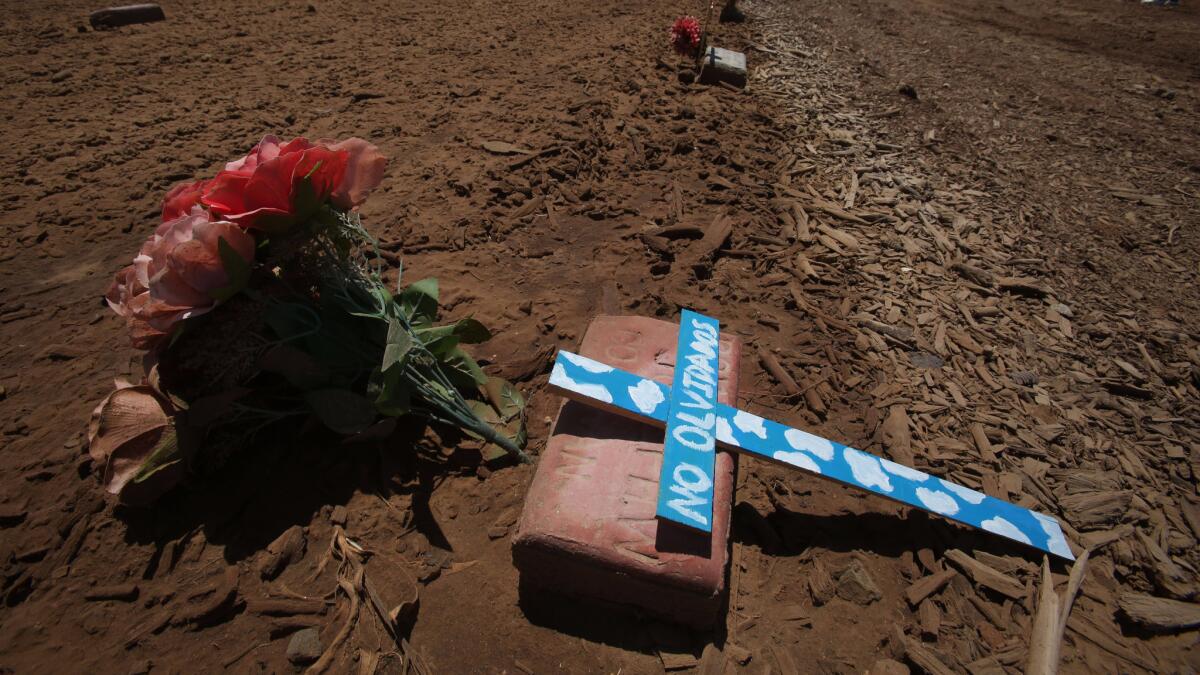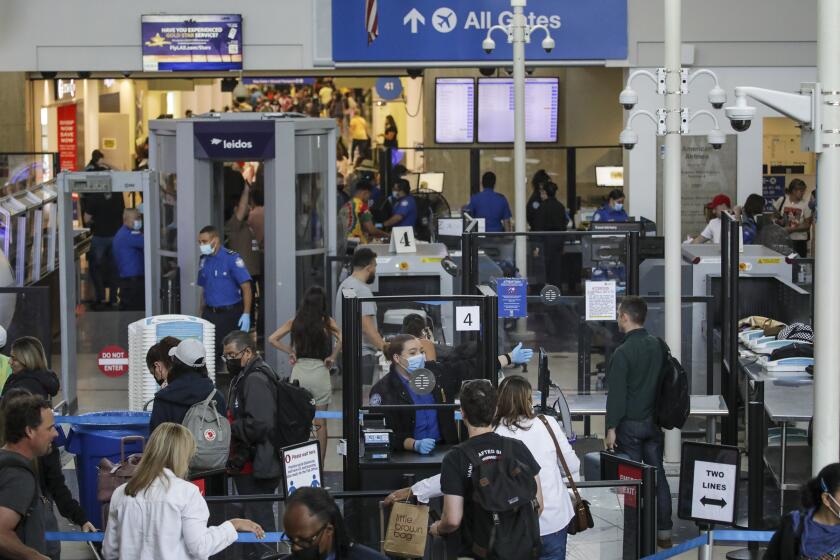Remains of hundreds of unidentified immigrants are buried in Imperial County cemetery

- Share via
In an unmarked dirt lot at the end of Terrace Park Cemetery in Holtville lie the remains of hundreds of unidentified migrants.
Most of these people died alone in the Imperial Valley desert or mountains, likely while attempting to illegally cross the U.S.-Mexico border. Some drowned in irrigation canals. Others died of thirst or exposure to extreme heat.
Each burial site is marked only with a large brick, each inscribed with the words “John Doe” or “Jane Doe” and a row number.
The expansive lot offers a stark contrast to the grassy, well-kept property at the front of the cemetery, where flowers and other mementos decorate the headstones that mark each grave. This pauper’s cemetery, about 125 miles east of San Diego, is one of the few known resting places for unidentified migrants who died on U.S. soil.
Migrant deaths are commonplace in the Imperial Valley, where summer temperatures regularly surpass 100 degrees. Many residents of the small town of Holtville have gone most of their lives without knowing about the dirt lot at Terrace Park. That portion of the cemetery remains closed to the public.
The last migrants were buried in that county-funded section of the cemetery in 2009, according to Terrace Park officials. Now whenever deceased migrants are found in this county, they’re cremated and their ashes are scattered at sea.
Their anonymity in death is an extreme reflection of the often desperate attempts by people to enter the United States. The flow of unauthorized immigrants has been a source of debate for decades.
Although pro-immigrant groups say the U.S. should welcome foreigners fleeing strife or seeking better economic opportunities, critics counter that unauthorized immigrants should be barred because they flout the nation’s rules and take resources away from Americans citizens.
It’s really sad because each one of these people, they did not expect to die when they crossed the border.
— Enrique Morones, co-founder of Border Angels
All of the cremations orchestrated by the Imperial County Public Administrator are taxpayer funded. Critics of illegal immigration said taxpayer funds used for the burial or cremation of undocumented immigrants means that less money is available for other important needs.
Donald Trump, the presumptive Republican nominee for president, has vowed to build a wall along the entire U.S.-Mexico border — and have Mexico pay for the project. When he announced his candidacy about a year ago, he made illegal immigration a prominent issue of his campaign.
Then there are groups like the San Diego-based nonprofit group Border Angels, which for the last 15 years has visited the dirt lot at Terrace Park to memorialize the migrants buried there. Volunteers place small, colorful wooden crosses inscribed with messages such as “No olvidados” (“Not forgotten”) and “Fe” (“Faith”).
“It’s really sad because each one of these people, they did not expect to die when they crossed the border,” Enrique Morones, a co-founder of the group, said during a recent trip to the cemetery. He travels to the site about every six weeks, often with students and other interested people.
Established in the 1930s, Terrace Park Cemetery eventually became part of the Central Valley Cemetery District, which also encompasses the Evergreen and Imperial cemeteries.
Imperial County began funding burials at Terrace Park for indigents in 1995 after space for such burials at Evergreen was exhausted, said Chuck Jernigan, superintendent of the cemetery district.
About 240 unidentified individuals are buried in the 3-acre dirt lot at Terrace Park, although Jernigan stressed that not all were migrants who died while crossing the border.
“There are people there who were not from a foreign country, but who were never identified,” he said.
In addition, more than 280 identified people are laid to rest in the same location, often because their families didn’t have the financial resources to pay for a funeral and gravesite elsewhere.
The pauper’s cemetery opened shortly after the 1994 establishment of Operation Gatekeeper, a program aimed at deterring illegal immigration at the U.S.-Mexico border in San Diego. Ramped-up enforcement in that area prompted migration patterns to shift eastward into the Imperial Valley and Arizona.
Should L.A. roll back its ‘so-called boycott’ on Arizona? »
Illegal immigration reached record highs in the following decade, with the number of immigrants in the U.S. illegally reaching a record 12 million around 2011. The current population is estimated at 11 million.
Today, more Mexican immigrants are returning to Mexico than those entering the United States, based on analyses by the Mexican National Survey of Demographic Dynamics, the U.S. Census Bureau and the Pew Research Center. Experts attribute the trend to various factors, including a stronger economy and a declining birthrate in Mexico.
There were about 240 deaths in fiscal 2015 along the U.S.-Mexico border, which includes the Border Patrol sectors spanning Southern California, Arizona and Texas, according to U.S. Customs and Border Protection.
In the El Centro sector, three deaths were recorded in 2013, six in 2014 and four last year, the agency said. By comparison, the same sector reported 90 deaths in 1998 and 56 the following year.
Five of the eight John or Jane Does found so far this year were unauthorized immigrants, the coroner’s office said.
Many victims underestimated the perils of their journey, carrying insufficient amounts of water, wearing the wrong type of clothing or wading across canals without knowing how to swim.
To make matters worse, smugglers often forbid clients from carrying I.D. as a way to cast off blame if migrants die or are apprehended.
“With John Does, we will use whatever means we can to identify these individuals,” said Sgt. Eric Frazier, supervising deputy coroner at the Imperial County coroner’s office. That includes fingerprint analysis and dental or DNA comparisons. Investigators also look for distinct tattoos, birthmarks or unique details in a decedent’s clothing that family members may recognize.
Such details are entered into a federal database of migrants and screened for potential familial matches.
The coroner’s office typically holds an unidentified body for 30 days after an autopsy is performed, in case it hears from family members. If the remains aren’t claimed during that period, they’re transferred to the Imperial County public administrator’s office, along with any property or clothing belonging to that individual.
MORE: Get our best stories in your Facebook feed »
The public administrator generally acts as a facilitator for the affairs of people who died and have no known relatives. The administrator works with the U.S. Border Patrol and the Mexican consulate in a bid to identify anonymous migrants.
The administrator’s office cremates unidentified migrants instead of burying them — a switch that saves the county roughly $860 a person, said Rosie Blankenship, assistant public administrator for Imperial County.
Two mortuaries in El Centro — Frye Chapel and Hems Brothers — are contracted to perform the cremations. Each cremation costs the county about $645, which is drawn from its indigent burial account.
The public administrator keeps the cremains in a secured vault for one year. If they aren’t claimed in that time, they are scattered at sea off San Diego.
tatiana.sanchez@sduniontribune.com
Sanchez writes for the San Diego Union-Tribune.
ALSO
Gov. Brown signs bill that could help immigrants get access to health insurance
California sees surge in Chinese illegally crossing border from Mexico
California leaders tell Supreme Court that undocumented workers are making the state stronger
More to Read
Sign up for Essential California
The most important California stories and recommendations in your inbox every morning.
You may occasionally receive promotional content from the Los Angeles Times.













